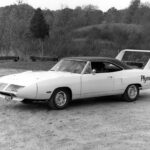‘Muscle cars’ of the late 1960s were probably introduced mainly for the spectacle of drag racing, which had become extremely popular in the United States at that time. Plymouth was always one of the leading exponents of the ‘muscle car’ and a lot of this was based around an engine – the astounding 426-111 Super Stock Hemi. This 90-degree V8 achieved much success for Plymouth and was the supreme drag-race powerplant, acquiring a legendary reputation.
The Hemi engine was born out of the need for top racing performance. Once the design had been proved and improved it began to be used in family sedans as an option. One of these, the Belvedere GTX eventually became the GTX Road Runner and later just the Road Runner.
When first offered it came in one of two body styles each with dummy bonnet scoops, special wheels, Road Runner nameplates and a decal of the cartoon bird of the same name on the sides and rear. It was also offered with a choice of two engines; either the small-block 383, with manifold and heads from the 440, or the 426 Hemi.
A popular option was a special handling package comprising anti-sway bar, heavy-duty shock absorbers, torsion bar and heavy rear leaf springs. In spite of its standard wide tyres the fact that it could travel at frightening speeds made a dangerous blend for a road-going car.
Designers used the science of vehicle aerodynamics with great skill when designing the Road Runner. By 1969 the dummy bonnet scoops became a real cold-air induction system and acquired the cute name of Coyote Duster, but the big change came in 1970 when Plymouth introduced the last of this model’s line-up. As with everything else about this car, the name was outrageously ostentatious: the Road Runner Superbird.
The Plymouth Road Runner Superbird was probably the most excessive vehicle of the entire ‘60s style phenomenon. With dual quad carburettors the 426 Hemi pumped out 317kW and was capable of speeds around 320km/h when in race trim. It was designed specifically for the NASCAR speedways with its pop-up headlights and huge rear wing. The 1920 examples built were offered to the public for one year only and all were sold.










